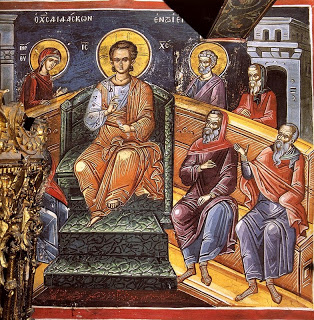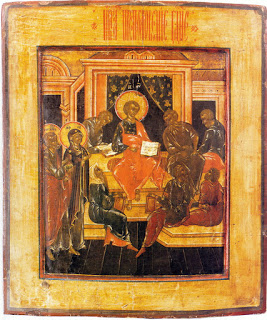Most icons showing biblical events from the traditional accounts of the life of Jesus make obvious sense in relation to the church year: the Nativity icon celebrates the event depicted, the birth of Jesus; the Baptism (Theophany) icon celebrates the baptism. Even the Indiction icon, which shows the beginning of Jesus’ ministry when he enters the synagogue at Nazareth and reads from the book of Isaiah, makes sense in its position as the beginning of the church year.
Today’s icon, however, does not make obvious sense, in spite of the fact that it is an easily recognized scene.

It depicts the event called in Western art “Jesus Among the Doctors,” recorded in Luke 2:41-49:
Now his parents went to Jerusalem every year at the feast of the passover. And when he was twelve years old, they went up to Jerusalem after the custom of the feast. And when they had fulfilled the days, as they returned, the child Jesus tarried behind in Jerusalem; and Joseph and his mother knew not of it. But they, supposing him to have been in the company, went a day’s journey; and they sought him among their kinsfolk and acquaintances. And when they found him not, they turned back again to Jerusalem, seeking him.
And it came to pass, that after three days they found him in the temple, sitting in the midst of the doctors, both hearing them, and asking them questions. And all that heard him were astonished at his understanding and answers.
And when they saw him, they were amazed: and his mother said to him, Son, why have you thus dealt with us? Behold, your father and I have sought you sorrowing.
And he said to them, How is it that you sought me? Know you not that I must be about my Father’s business?

Mid-Pentecost happens on Wednesday in the middle of the fourth week after Easter, halfway between Easter and the festival of Pentecost (the celebration of the Descent of the Holy Spirit on the Apostles), sometimes called “Whitsun” or “Whitsunday” in the West. So that is what this icon type signifies in the Eastern Orthodox liturgical year: the festival that occurs halfway between Easter and Pentecost — in “the middle.” It is rather odd that the image of the young Jesus among the elders became used for Mid-Pentecost, because the biblical text that connects the Mid-Pentecost icon type with that festival, and is sometimes used as the title of the icon, actually refers to a different (but similar) event supposedly later in the life of Jesus, as written in John 7:14- Now about the midst of the feast Jesus went up into the temple, and taught. And the Jews marveled, saying, How knows this man letters, having never learned? Jesus answered them, and said, My doctrine is not mine, but his that sent me.
The excerpt sometimes used as the title inscription for this icon type is:
“ВЪ ПРЕПОЛОВЕНИЕ ПРАЗДНИКА ВЗЫДЕ ИИСУСЪ ВО СВЯТИЛИЩЕ” (V’ PREPOLOVENIE PRAZDNIKA VZUIDE IISUS’
VO SVYATILISHCHE “In the Middle of the Feast Jesus Entered into the Temple…”)
That excerpt originally referred to the adult Jesus and to the Jewish feast of Sukkoth, but Eastern Orthodoxy made use of that “middle of the feast” notion to apply the image instead to Mid-Pentecost. All in all, it makes for rather confused and stretched connections, but that is tradition. In any case, it shows us how intimately icons are connected with the liturgical calendar of Eastern Orthodox Church.
The troparion for the Mid-Pentecost festival also makes use of that “middle of the feast” concept:
Тропарь, глас 8
Преполовившуся празднику, / жаждущую душу мою благочестия напой водами, / яко всем, Спасе, возопил еси: / жаждай да грядет ко Мне и да пиет. / Источниче жизни нашея, Христе Боже, слава Тебе.
Troparion, voice (tone) 8:
In the middle of the feast, fill my thirsty soul with the waters of piety, as to all, Savior, you cried: Let the thirsty come to me and drink. Fountain of our life, Christ God, glory to you.

In Russian Orthodoxy, Mid-Pentecost is traditionally a time when both the fields and water are ritually blessed. The type varies slightly from example to example. In this one Joseph and Mary stand at left, and the youthful Jesus is seated in the Temple amid the elders, discussing texts with them. Jesus holds an open book. In some other examples, he holds a rolled scroll.

 It depicts the event called in Western art “Jesus Among the Doctors,” recorded in Luke 2:41-49:
It depicts the event called in Western art “Jesus Among the Doctors,” recorded in Luke 2:41-49:

 In Russian Orthodoxy, Mid-Pentecost is traditionally a time when both the fields and water are ritually blessed. The type varies slightly from example to example. In this one Joseph and Mary stand at left, and the youthful Jesus is seated in the Temple amid the elders, discussing texts with them. Jesus holds an open book. In some other examples, he holds a rolled scroll.
In Russian Orthodoxy, Mid-Pentecost is traditionally a time when both the fields and water are ritually blessed. The type varies slightly from example to example. In this one Joseph and Mary stand at left, and the youthful Jesus is seated in the Temple amid the elders, discussing texts with them. Jesus holds an open book. In some other examples, he holds a rolled scroll.



